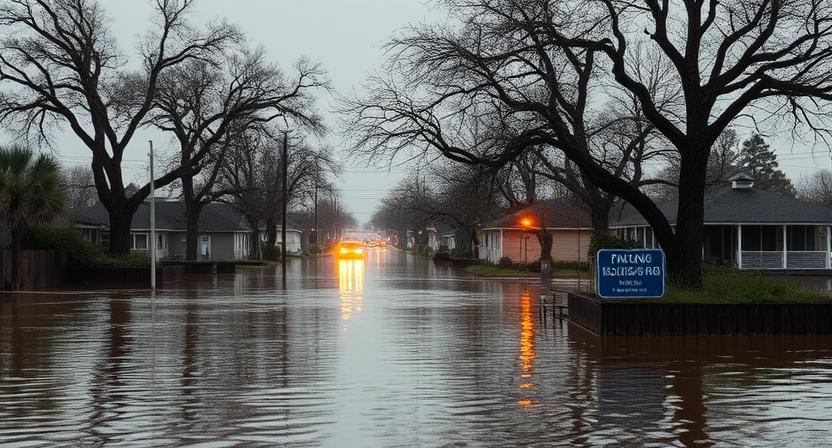What caused the flooding in Texas is the question everyone is asking after deadly rains hit Hill Country in July 2025. More than 50 people died. Over 850 were rescued. Many more are still missing.
Homes, roads, and businesses were washed away in hours. The scenes were shocking. But what led to this sudden disaster?
In this post, we break down exactly what caused the flooding in Texas. We explain the rain, the land, the rivers, and more. By the end, you’ll understand how so much damage happened so fast.

1. Heavy Rain Fell Fast and Hard
The first reason what caused the flooding in Texas was extreme rain. This was not a slow storm. It was fast and violent.
In just three to four hours, up to 15 inches of rain fell in parts of Central Texas. Some areas saw nearly a year’s worth of rain in one night. The hardest-hit towns were Kerrville, Ingram, and Comfort.
Rain like this is rare. It came down so fast that it turned roads into rivers. Cars floated. Buildings flooded within minutes. The soil could not absorb it.
2. The Ground Couldn’t Hold the Water
Next in what caused the flooding in Texas is the ground itself. Texas Hill Country has rocky land. It doesn’t soak up water well. That’s a big problem when rain comes fast.
When the soil is dry and hard, water runs right off. It flows into streams and creeks. These fill up quickly and overflow. That’s exactly what happened.
This part of Texas is known for flash floods. It has steep hills and deep valleys. Water doesn’t spread out. It speeds downhill fast. This turns creeks into raging rivers in minutes.
3. The Guadalupe River Rose 29 Feet in an Hour
One of the scariest parts of what caused the flooding in Texas was the surge of the Guadalupe River.
In some places, the river rose 22 to 29 feet in just one hour. That’s not normal. It’s dangerous.
Homes near the river were swamped. People were trapped in cars, rooftops, and trees. First responders used boats and helicopters to rescue as many as they could. But the water came too fast in many cases.
The river had no time to move the water downstream. It backed up and spilled over. That’s when the worst damage hit.
4. The Storm Didn’t Move
Another big part of what caused the flooding in Texas was a stalled storm. Normally, storms pass through. This one didn’t.
A large storm system parked over Central Texas. It didn’t move for hours. It kept dumping rain in the same spots over and over.
Why didn’t it move? Weather experts say the jet stream was weak that night. The storm had no push to move east or west. So, it stayed in place—and kept raining.
This was bad luck and bad timing. It’s rare, but when it happens, it leads to disaster.
5. Warm Air Held More Moisture
A quiet cause of what caused the flooding in Texas was the air itself. Warm air holds more water. That’s a fact.
This storm pulled in moist air from both the Gulf of Mexico and the Pacific Ocean. The air was hot and full of water. That gave the storm extra fuel to drop heavy rain fast.
Many scientists say that warming air makes storms like this worse. Whether you agree or not, it’s clear that this storm had more water to work with than most.
6. Nighttime Timing Made Things Worse
When we ask what caused the flooding in Texas, we can’t ignore the time it hit.
The storm came overnight. Many people were asleep. They didn’t hear alerts or see rising water until it was too late.
By the time they woke up, roads were flooded. Water was already inside homes. Many had no time to escape. That’s why the rescue numbers were so high.
If this storm had hit during the day, more people may have had time to act.
7. Flash Flood Alley Is Always at Risk
Texas Hill Country is part of what experts call “Flash Flood Alley.” It’s one of the most flood-prone places in the U.S.
This region gets heavy rains often. But the land, rivers, and weather patterns make it worse. Water doesn’t just sit. It races.
When asking what caused the flooding in Texas, this fact matters. This area is built for sudden floods. Towns, roads, and homes are often too close to rivers and creeks.
People who live here know the risk. But even for them, this flood was far worse than expected.
8. Emergency Alerts Were Not Enough
Part of what caused the flooding in Texas was missed warnings.
The National Weather Service did issue alerts. But they expected moderate flooding—not a historic disaster. The rainfall was stronger than their models predicted.
Many people didn’t get flood alerts in time. Some counties didn’t sound sirens. And many families had no warning that they were in danger.
Better systems may have helped. But no one expected the rivers to rise this fast.
9. Rescue Crews Did All They Could
After the storm hit, help came fast. Over 850 people were rescued by air, boat, or high-water truck. Firefighters, police, National Guard, and volunteers all joined in.
But the damage was huge. Some places were cut off for hours. Roads vanished. Power lines fell. Cell service dropped.
Many families lost everything. Some lost loved ones. Others are still searching.
10. The State Declared an Emergency
The Texas governor signed disaster orders for more than 14 counties. This unlocked aid, rescue tools, and cleanup funds.
Shelters opened across the region. Crews cleared roads. Volunteers brought food and supplies.
But full recovery will take time. The water ruined homes, businesses, farms, and schools. Some towns may take years to rebuild.
11. Can Texas Prevent This Again?
People are asking: can we stop this from happening again?
We can’t stop rain. But we can prepare. That includes:
- Better drainage in flood zones
- Stronger early warning systems
- Smarter building laws near rivers
- Community training and flood maps
Texas leaders are now looking at new plans. Some want new rules about building in risky areas. Others want more funding for flood response.
12. What Caused the Flooding in Texas: The Full List
To review, what caused the flooding in Texas in 2025?
- Record-setting rain in a short time
- Rocky land that couldn’t absorb water
- Rapid river rise—up to 29 feet in an hour
- A stalled storm that didn’t move
- Hot air full of moisture
- Nighttime timing
- Flash flood-prone land
- Limited warning systems
- Lack of flood-safe development
Each piece added to the disaster. Together, they caused one of the worst floods in Texas in years.
Final Thoughts
What caused the flooding in Texas is not just one thing. It was a mix of nature, weather, and unprepared land.
The damage is done. Now comes the hard part: rebuilding and getting ready for next time.
Texas knows floods. But this one was different. It showed how fast things can change. And it reminded us all how important planning and warning systems are.
Let’s hope lessons are learned—and lives are saved next time.





